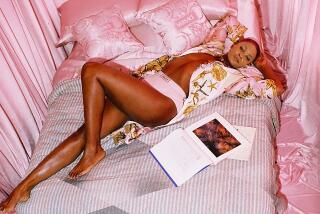Trendy Colors, Fabrics Are a Soft Touch
- Share via
There may be crime and grime in the streets, but it’s a softer, gentler world at home.
That’s because the emphasis is on textiles with softer textures and lighter colors.
“The wish for the home to be a refuge and place of comfort is the driving force behind the rise of softer colors,” Leatrice Eiseman says, citing fabric in colors such as baby-blanket blue and pale beiges with benign names like cloud cream, cream pearl, Angora and pale banana.
“People are even more drawn to a soft color in a soft texture because of the please-touch quality,” says Eiseman, director of the Pantone Color Institute in Carlstadt, N.J., which tracks color trends. “Anything in soft cotton or a plush construction such as chenille is doing well. Nubby fabrics also are successful if the nub is very soft.”
Practically speaking, the place to start this quiet revolution is in areas that are off-limits to kids, such as the master bedroom and bath or the guest bedroom.
For fall, manufacturers established a quiet zone for bed and bath, marketing everything from cotton knit sheets to fluffy chenille, wool mohair and lambs wool throws in soft colors. Guess Home’s cotton jersey bedding should be in stores early this year.
“Cotton jersey is even softer than the typical percale,” says Michel Benasra, chief operating officer and design director of Guess Home in Los Angeles.
The bedding, prewashed for softness, comes in chambray blue, heather gray and pinstripes of red and blue against white.
Jack Toolan, senior vice president of Westpoint Stevens Home Fashions in New York, says nearly all suppliers are offering sheets with a higher thread count, towels made of finer cotton and “special weaves such as sateen and velours that add up to softer textiles for the bedroom and bath.”
Toolan says the shift to soft has been accelerating in the last couple of years, with an increase in luxurious textures in a wider range of stores and at prices that, while high, are within reach of the middle class.
Westpoint Stevens introduced cotton sateen sheets in its Silk Pajamas collection, a splurge at $75 for a queen size. For softness on a budget, the company’s Weekend collection includes natural cotton sheets with simple prints, $28 for a queen flat.
Velour towels, in and out of vogue, are back. Westpoint Stevens has added a velour made of Egyptian cotton, $15 for a bath size. Pipeline, $8 for a bath size, is back this fall, a revival of the 1980s.
“In sheet colors,” Toolan says, “we believe that pastels will be quite popular in the coming months in place of the dark hunter greens, burgundies and navy.”
Dual themes of softness and quietness are playing well in the living room too.
“With upholstery fabrics, people are into touch, feel and texture, and anything chenille is selling very well,” says Thomas Burak, vice president and design director for Schumacher Fabrics in New York.
Soft fabrics are a major part of Schumacher’s January introductions. New fabrics include several chenilles with two-tone effects, such as a subtle plaid and a chenille stripe damask, and a woven check with a chenille dot. Other upholstery fabrics in the January debut are corduroy with wide and narrow ribs and an ottoman with horizontal ribs.
“We also see a trend to silk,” Burak adds.
Silk is soft to the touch, and the luster of the threads will make the color appear mellower and more subtle than another fabric.
Burak, a longtime observer of the industry, says the days of mixed patterns and vivid colors, for the bedroom and elsewhere, are on the wane.
“Many people have become tired of this look,” he says, “and prefer taupe, beige and bone.”






